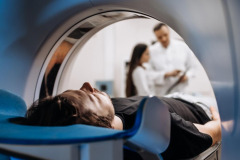What Is a CT Scan?
A computed tomography scan is more commonly known by its shortened form of CT scan. This test is a painless and non-invasive X-ray imaging technique. What sets it apart from a standard X-ray is that it includes numerous images taken at a range of angles, to see more than a typical X-ray allows. A CT scan is able to create very detailed three-dimensional images of internal structures in the body.
How Does A CT Scan Work?
CT scans utilize X-ray imaging, but while a conventional X-ray generates a flat, 2D image that is more often used to scan and diagnose bone and bone-related disorders, heart and lung problems, or to identify blockages or foreign objects, a CT scan can help medical providers peer deeper into soft tissues. It does this by utilizing an X-ray generating device that rotates around a patient’s body. The images are then processed using a powerful computer that is able to assemble the images to create cross-sectional, multi-dimensional internal images. With these more detailed and accurate images available, healthcare professionals are better able to diagnose and treat a range of medical conditions.
Certain types of CT exams may require that a patient take a contrast agent in order to provide an enhanced image. Oftentimes a contrast test is used when a physician is looking at specific tissues, organs, blood vessels, tumors, or infections. Regardless of whether the test requires a contrast or not, CT scans are invaluable for healthcare practitioners to get a more precise view of what’s going on internally, especially when the organs or body structures in question are overlapping one another.
What Does A CT Scan Show?
A CT scan is used to take pictures of various internal structures of the body, including:
- Bones
- Muscles
- Organs
- Blood vessels
In the resulting images, CT scans are valuable tools that can help healthcare providers to detect, diagnose and treat various injuries and diseases, including:
- Tumors (both cancerous and benign)
- Fractures and broken bones
- Heart disease and blood clots
- Bowel disorders
- Kidney stones
- Brain and spinal cord injuries
- Internal bleeding
What To Expect During A CT Scan
A patient will most often lie flat on their back on a bed-like table during the duration of the test. The bed will be surrounded by a doughnut-shaped scanner. In order to get clear images, it is absolutely necessary to remain still. This may require holding one’s breath for a short time during the test. If a contrast agent is required for the test, it will be administered as is appropriate for the organs being observed (orally and intravenously). It is possible that the dye could make a patient feel flushed or produce a metallic taste in the mouth. The X-ray generating equipment will then silently record the required images, with the scan itself typically only lasting several minutes.
Imaging Diagnostics In Cleveland and Columbus, Ohio
At Advantage Diagnostics, we are always working to improve our offerings and make testing as comfortable and as low-stress as possible for our patients. So we are thrilled that Fujifilm's Supria Plus CT is now at our Beachwood location. This newer form of CT equipment offers advanced clinical capabilities and is specially designed to offer a more comfortable experience for all patients. From its larger opening, lower table, lower radiation dose capability and capacity for generating images of the very highest quality along with powerful 3D visualization tools, this new and improved CT scan offers the best results available. Contact us today to learn more about our services and doctors and to find out how you can get a referral for testing.

